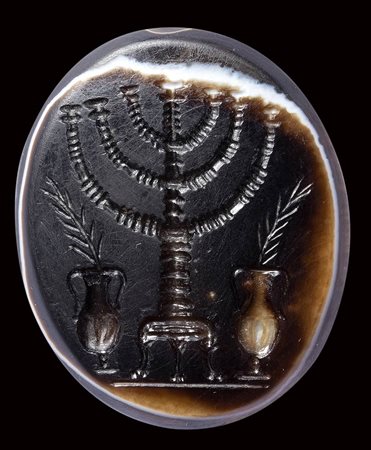 Bertolami Fine Art - Riversdell Close 27, KT16 9JW Chertsey
Bertolami Fine Art - Riversdell Close 27, KT16 9JW Chertsey
Auction 86 - Glyptics and Ancient Jewelry sessione unica
Wednesday 9 December 2020 hours 14:00 (UTC +01:00)
A rare and large roman sardonyx intaglio. Seven-branched menorah.
A rare and large roman sardonyx intaglio. Seven-branched menorah.
1st - 5th century A.D.
30 x 37 x 4 mm
The Second Temple’s seven-branched candelabrum with three animal claws (according to Jewish tradition, the candelabrum was three-footed), with, on each side, a palm branch (lulav) in kantharos. Groundline.
The sense of execution with refined incision to enhance some details of the candelabrum branches, the pedestal and the belly of the kantharos demonstrate a high skilled technic.
This probably indicates a specific command for an important personality.
The seven branched menorah with conical foot appears on the last Hasmonean coinage imagery (40-37 B.C.) and then, not employed during the two Jewish wars against Rome. Although the interdiction of representation was in force at this time, the rabbinical ruling authorized jews to own seals with images even made by pagans as long as it was not meant for worship, but for sealing, or decorative purposes (see. Spier, J. Late Antique and Early Christian Gems, 2013, pp. 159-161).
Hence, the widespread of a certain type of jewish imagery during the Roman Imperial period can be identified in major part with the seven-branched candelabrum, which was the most significant and popular Jewish symbol of the graeco-roman period (one of the most known example is the high relief on Titus Arch in Rome, made in 81 A.D. by Titus’s brother, the emperor Domitian).
A similar iconography with the kantharos on each side and palm branch is represented on one facade of the Magdalena stone discovered in Galilea and dated from the 1st century A.D. The use of animal (lion type) claws for the base of the candelabrum remind one precisely of the Pompeii candelsticks and of the sarcophagus in the Villa Torlonia.
In fact, this particularity begins in the late Hellenistic period, at the time of the Second Temple was erected, the animals representations of the Near-East was exercising a strong influence on Hellenistic art.
Various wear signs on both side. Very attractive stone. Large dimension.
Parallels :
Spier, J., Late Antique and Early Christian gems, pl.121, n°941-943
Strauss, H., The History and Form of the Seven-Branched candlestick of the Hasmonean King, Journal of the Warburg and Courtauld Institutes,Vol. 22, No. 1/2 (Jan. - Jun., 1959), pp. 6-16
U.K., private collection, 70's-80's, London.









